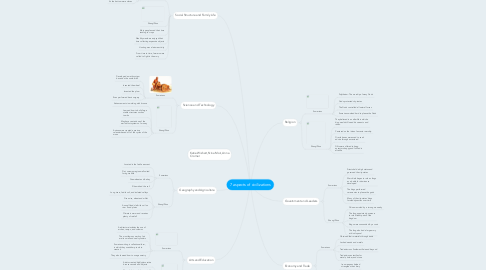
1. Science and Technology
1.1. Sumerians
1.1.1. Developed a math system based on the number 60
1.1.2. Invented the wheel
1.1.3. Invented the plow
1.1.4. Even performed basic surgery
1.2. Shang/Zhou
1.2.1. Advancements in working with bronze
1.2.2. Learned how to build large stable structures such as tombs
1.2.3. May have ceated one of the worlds first systems of money
1.2.4. Astronomers created a precise calendar based off of the cycles of the moon
2. Geography and Agriculture
2.1. Sumerians
2.1.1. Located in the fertile crescent
2.1.2. Flat, swampy region well suited for agriculture
2.1.3. Grew wheat and barley
2.1.4. Slit enriched the soil
2.2. Shang/Zhou
2.2.1. Long rivers, fertile soil, and isolated valleys
2.2.2. Grew rice, wheat and millet
2.2.3. Annual floods left rich soil on river flood plains
2.2.4. Climate is warm and receives plenty of rainfall
3. Arts and Education
3.1. Sumerians
3.1.1. Architecture includes the use of arches, ramps, and columns
3.1.2. The most famous works of art are its small and seal cylinders
3.1.3. Sumerian writing is called cuneiform, in which they used sharp tools to create it
3.1.4. They also learned how to use geometry
3.2. Shang/Zhou
3.2.1. Artists created highly decorative bronze vessels and objects
3.2.2. Were able to make huge, stable structures such as tombs
3.2.3. The development of writing was closely tied to the use of oncle bones
3.2.4. Early Shang texts used pictures to represent things of objects
4. Social Structure and Family Life
4.1. Sumerians
4.1.1. At the top were priests, kings, and their principal agents
4.1.2. Next were large landowners and wealthy merchants
4.1.3. Below them were artisans, farmers, and laborers
4.1.4. At the bottom were slaves
4.2. Shang/Zhou
4.3. Most people used their time tending to crops
4.4. Wealthy members enjoyed their time collecting expensive objects
4.5. Hunting was a leisure activity
4.6. From time to time, farmers were called to fight in the army
5. Katie Wishart, Nina Moir, Anna Cromer
6. Religion
6.1. Sumerians
6.1.1. Polytheism- The worship of many Gods
6.1.2. Gods protected city-states
6.1.3. The Gods controlled all natural forces
6.1.4. Sumerians worked hard to please the Gods
6.2. Shang/Zhou
6.2.1. They believed in an afterlife in which a king would still need his servants and riches.
6.2.2. Centered on the idea of ancestor worship
6.2.3. Oracle bones were used to seek advice through ancestorsd
6.2.4. Gifts were offered to keep ancestors happy and fufilled in afterlife
7. Government and Leaders
7.1. Sumerians
7.1.1. Priests held a high status and governed the city-states
7.1.2. War chiefs began to rule as kings as a battle for dominance developed
7.1.3. The kings performed ceremonies to please the gods
7.1.4. Many of the city-states' kings formed dynasties over time
7.2. Shang/Zhou
7.2.1. China was ruled by a strong monarchy
7.2.2. The king appointed governors to rule distant parts of the kingdom
7.2.3. Kings were surrounded by a court
7.2.4. The king also had a large army at his disposal
8. Economy and Trade
8.1. Sumerians
8.1.1. Obtained their materials through trade
8.1.2. Lacked woods and metals
8.1.3. Traded across Southwest Asia and beyond
8.1.4. Traded woven textiles for metals, timber, and stone
8.2. Shang/Zhou
8.2.1. Iron weapons helped strengthen their army
8.2.2. Farmers learned techniques that increased food supply
8.2.3. Zhou introduced coins to China and began the use of chopsticks
8.2.4. An increase in population led to roads and canals
